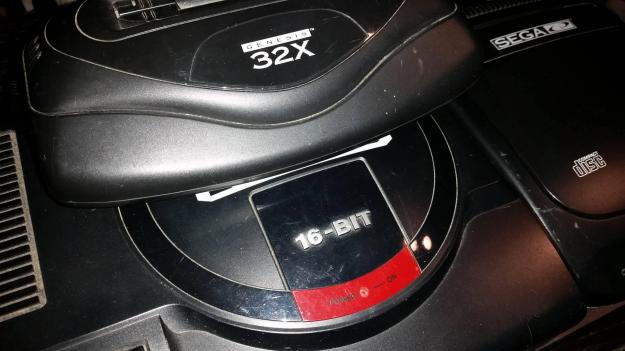
“WELCOME TO THE NEXT LEVEL.”
So said the ads of the 1990s, and here, now, some 22 years or so after I should have gotten all that I could out of the system, I feel I have finally, finally reached that mythical “next level.” Bear with me for the duration of this post gang, because I’m about to incoherently babble about the quest and ultimate fulfillment of getting all that I possibly could out of my trusty Sega.
Now, you have no idea how much I love the Sega Genesis (known as the Sega Megadrive everywhere but in the US; it’ll always be a Genesis to me, deal with it bucky). Indeed, in the realm of my personal favorite video game consoles, the Genny is second only to the Nintendo Entertainment System; no two other systems hold quite such an esteemed place in this heart of mine, dubious honor that may be. In fact, the Genesis has the distinction of being the first console I ever purchased new with my own money, at the long-gone and much-missed Sun Electronics store that once resided a short distance from me. Ah, the 1990s!
Even though the Genesis alone is more than enough to rank among my top favorite systems, the fact that it can be expanded, and expanded mightily, only adds to the personal appeal. So then, just how do you go about beefin’ the console to maximum capacity? What more could possibly be added to what is generally considered one of the greatest video game systems of all-time? Well, by doing what so many gamers back in the 1990s did (or so Sega hoped), and what so many gamers continue to do (or so I hope): I’ve attached the Sega CD and Sega 32x add-ons to my console, that’s what I did! Look up above if you don’t believe me!
“y u doin this bro?”
It’s a question classic gamers probably wouldn’t ask, even though the CD and 32x add-ons, or more specifically their libraries, are often considered, well, kinda negligible. The gaming world at large, I’m not sure they’d get it, but since I give 0 about the current generation of consoles, and never stopped loving the systems I grew up with besides, this just feels right. Plus, this fits in to the current wave of 1990s nostalgia I’ve been riding as of late; even though I didn’t own these add-ons new back in the day, I still fully expect to continuously check my watch to make sure Boy Meets World hasn’t started yet whilst playing this big hulking mound of plastic.
“Wuts a cd 32x bro?”
As you may surmise, the Sega CD was an attachment that allowed for bigger, more powerful games and CD-quality soundtracks via, say it with me, compact discs. The 32x was a cartridge-based attachment that, as you also may surmise, gave the Genesis 32-bit capabilities and thus even bigger, more powerful games. Theoretically, anyway; general consensus is that neither attachment lived up to their potential on a regular basis, and I’m not sure I’d have been happy with them had I paid full price back in the day. Now though? There’s enough good stuff to make me feel I got my money’s worth – especially since I got ’em on the cheap years ago.
I had only limited experience with the add-ons prior; my cousin had both, and I recall once playing Sewer Shark on the CD and Star Wars Arcade on the 32x at his house, way back in 1995 or so. For all intents and purposes however, getting these attached to my Genesis was my first real experience with them, and therein lies my tale. So read on! (And please ignore some of the dust I neglected to clean before snapping photos; frankly, you’re lucky I even gave a cursory soft-cloth wipe-down before taking pictures.)
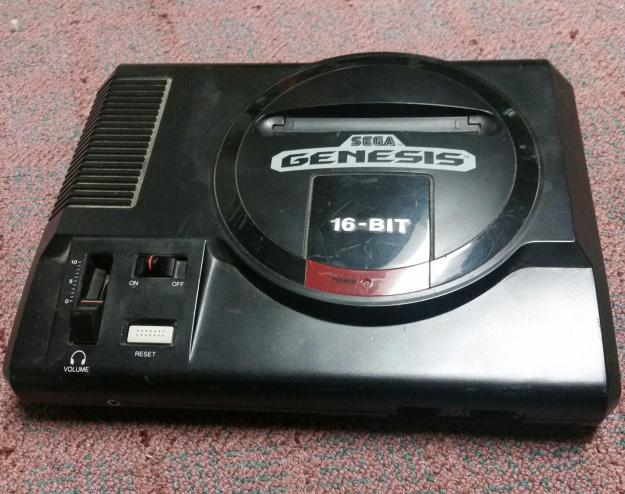
Anyone reading almost undoubtedly has to know what a Sega Genesis looks like. For the .01% of you that don’t, up above is a model 1 Sega Genesis – bare, naked, unbeefed. This isn’t the Sega that I regularly use, and thus isn’t quite the subject of this post. Rather, this is just a spare I’ve wound up with. What, you thought I was gonna unplug all of the attachments just to get a photo of my “playing” Sega without the, as you would say, accoutrements? Think again, chief.
Actually, the system above was the console that the CD and 32x attachments originally came with. I picked the whole set up cheap at a thrift store in late-2010 – and then proceeded to do nothing with any of it. Despite the included mess of cords, I still didn’t think I had all of the necessary attachments, and it promptly became part of the messy mosaic of boxes that made (make) up my increasingly cluttered basement. I never regretted the purchase, because hey, most of the stuff was there, and the price was definitely right (especially compared to the climbing 16-bit prices nowadays), but it wasn’t until recent months that I decided to do something with the lot.
Y’see, the Genesis that I normally use, another model 1 which I picked up years ago at a rummage sale (to the best of my recollection), I’ve kept hooked up as my “playing” unit for quite some time. The room where I have it includes a big, beautiful, vintage Sony Trinitron CRT TV, with built-in speakers on its sides and a stand that also serves as another speaker. It’s my “go-to” classic gaming TV, and for awhile, I had a myriad of consoles daisy chained to it. Eventually I decided to declutter, and instituted a personal “only one system at a time!” rule for the TV, with the beater Genesis getting the nod. That’s the place it has held ever since, and luckily, my pretentious little rule doesn’t preclude add-ons, since it’s still technically only one console. This is important stuff, so pay attention.
I went with the Genesis as my console of normative choice simply because I have stacks and stacks of games (a library that includes more than a few all-time favorites), I’ve got plenty of spare consoles should this one die (yeah, like these things won’t outlive us), and there’s a lot of bases covered by it; legit 16-bit gaming, of course, but also 8-bit via the Sega Master System converter (the SMS is a system I absolutely adore and thus this aspect was a huge factor in my decision), plus, needless to say, now CD and 32x games are in the mix, too. Sega was the king of add-ons in the 1990s, and while that ultimately had a large part in crippling their future (more on that momentarily), for me right now, I love the options at my disposal.
So, as I steadily decided to expand my “playing” Genesis, I simply removed from that thrift store buy what I wanted to use on my ‘good’ console. I initially didn’t intend on using all of it, which I’ll explain in a bit.
When I bought my first Genesis new way back when, it was a model 2; a smaller, sleeker, more streamlined beast. I loved it, and still have it of course, but even then I liked the look of the first model more. There are certain positives and negatives regarding both variations, though the model 1 is easily my preferred choice – especially since the the SMS converter won’t fit on a model 2!
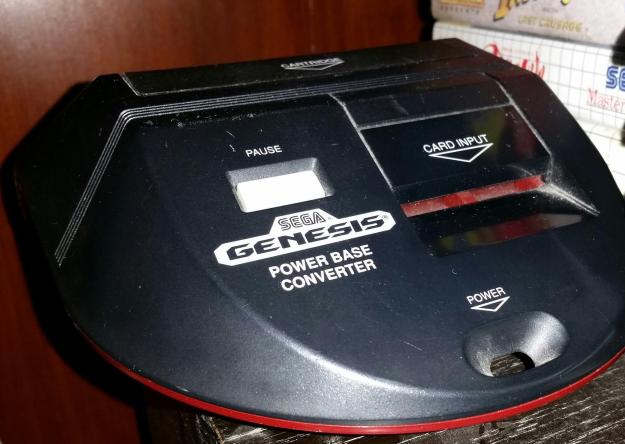
Though not really the subject of this post, I mentioned that whole model 1/model 2 thing just now because the Master System adapter, the Power Base Converter, really did play a part when I was thinkin’ ’bout beefin.’
Via this converter, my SMS library has probably gotten just as much playtime as my Genesis games have. Now, I have an actual SMS, but again, that would require two consoles being out, which would start me on the slippery slope towards cluttering up mah space again. The Power Base Converter does pretty much everything a ‘real’ SMS can do (no built-in game, though), and aside from a few (but just a few) games not liking a Genesis controller (gotta use a legit SMS pad for Bomber Raid, dawg), I have no issues with it. Indeed, I love the lil’ feller, and it fills me with a burning rage that it kinda flies under the radar when the subject of Genesis add-ons are brought up at sophisticated dinner parties and whatnot.
So what was my concern regarding the converter? From how I understand it, the adapter basically acts as a pass-through, and all of the stuff to make an SMS game ‘go’ is already in the Genesis. However, when you attach a 32x, which allows you to play regular Genesis games through it (lest you have to un-hook & re-hook the thing every time the 16-bit fancy strikes you), I guess it somehow disables the whatever that allows the Power Base Converter to function. This hurts me deep, even if plugging the converter into the 32x would make the set-up the ugliest monstrosity in console history. The Genny ain’t exactly winning any awards in that area when all beefed up like this, anyway.
Simply put, taking the Power Base Converter out of the equation was not an option. This was non-negotiable. Luckily, I worked out a solution that, while still requiring some unplugging and whatnot, at least keeps my SMS-capabilities on the table; I will not bar myself from readily-accessible Rambo: First Blood Part II! (The SMS game I mean, not the movie – though I won’t bar myself from the flick, either.)
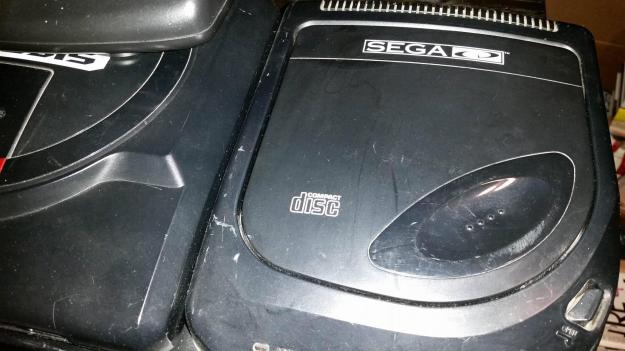
What got this whole “Ah wanna upgrade mah Sega” thing started was actually the CD. Not Sega’s CD attachment, mind you, but rather the Turbografx-16’s. Or rather, the later TurboDuo combo console. I had been reflecting on my good fortune in obtaining the Duo several years back (it was still pretty expensive, but not “hold your head in your hands and weep bitterly” expensive like it is now), when I realized, hey, I play my Genesis much more than anything right now, so why not take the Sega CD plunge and expand a bit?
My first thought was to pick up a model 1 Sega CD, which was a big hulking unit with a motorized disc tray, and which sat directly beneath the Genesis. I had a chance to pick one of those up (with yet another Genesis) several years back too, at a decent-compared-to-now price, but unlike my TurboDuo, I failed to use my bean and decided against it. Mistake.
In all honestly, at first I didn’t even think of using the model 2 Sega CD that I already had and was currently languishing somewhere in my basement. Eventually, the gears started turning in my noodle, I dug the thing out, and I went to figure out how I could make it “go.” Initially, I only intended it as a placeholder until I could find a halfway-reasonable model 1 CD, and while I won’t say that option is completely off the table, I’d have to come across an original unit in-person and for a great price to make me drop some of my increasingly limited dough on it.
The model 1 Sega CD was first released in the US in 1992, and a year or so later, the redesigned model 2 CD came. Primarily intended for use with the Genesis model 2, the second iteration of the Sega CD used a pop-up disc tray lid and sat next to the Genesis. Luckily for me, this revised Sega CD works just fine with the model 1 Genesis. (Which makes sense, since it came with one when I first brought it home!)
As I said before, when I originally bought my Genesis/CD/32x set-up from the thrift store, I didn’t think I had all the right cables and whatnot. Just looking at the back of this Sega CD, the numerous ports had me confused. Sure, the power supply is self-explanatory (and luckily mine came with one; same as a model 1 Genesis power supply), but the rest? Separate AV jacks? “Mixing?” What have I gotten into?! No wonder I threw all this stuff in a box and let it sit for almost 7 years!
Fortunately, a quick look online revealed that I did indeed have the bare minimum to get this thing running. All I had to do? Connect it to the Genesis’ expansion port, plug the power supply in, and bingo! The Genesis handled the rest! Cool winnins! (There are some metal RF shielding plates that came with the CD, which you screw in the bottom of the Genesis to both better prevent RF interference and to attach it more securely to the CD. I had these and did indeed attach them, but they’re not absolutely necessary.)
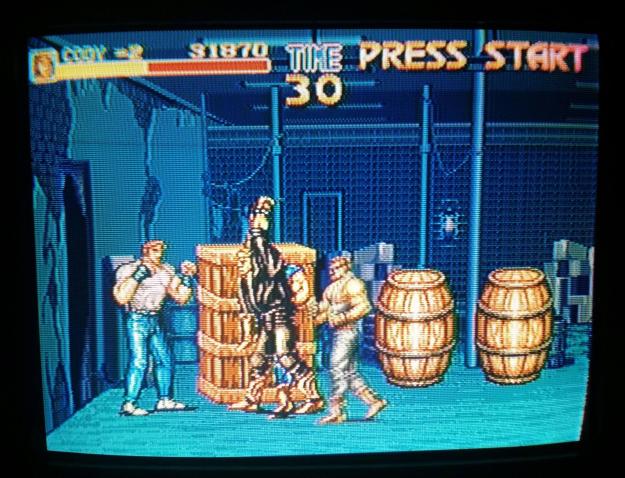
The Sega CD had garnered a decently-sized library before being discontinued in 1996, though oddly enough, as soon as I got mine hooked up, I was sort of at a loss as to what I was really going to go after (barring one exception). The fact my player had been sitting around my basement for nearly 7 years had me wondering if the thing even still worked. A quick trip to a nearby thrift shop yielded me a cheap copy of Bill Walsh College Football, purchased solely for testing purposes (I’m not a college football fan, and frankly, I’m not huge on 16-bit football games in general). Maybe not the best demonstration of the CD’s power, but it told me that my Sega CD was indeed operational.
My first real Sega CD game, as far as one I wanted goes, was Sol-Feace, a terrific horizontal shooter that was actually a pack-in with the original release of the Sega CD. While maybe not a stellar showcase of the CD’s abilities (except for the soundtrack, which I dig), it’s still a blast, and saves me the trouble of tracking down the Genesis cartridge port (titled Sol-Deace; Phil Moore always had fun saying that title on Nick Arcade).
After that was the CD port of Bram Stoker’s Dracula. Unlike many Sega CD games, which were just enhanced versions of Genesis games, Dracula is actually a totally different game from the ‘regular’ edition. Featuring actual clips from the movie, digitized characters, and backgrounds that rotate as you pass through them (think Fleischer Popeye), it’s an impressive title for 1993, and unlike the last two games, a real showcase of what the Sega CD can do. Okay, technically it’s a mediocre, single-plane Beat-‘Em-Up, but it looks so neat that I wound up being fond of it nevertheless.
But actually, it was Final Fight CD, which you’re looking at live and in action above (in a shot crummily taken of it playing on my TV because I don’t emulate; it looks better in real life, trust me!), that was the main driving force behind getting me to hook up the CD. Y’see, I’m a Beat’ Em Up junkie; it’s quite possibly my favorite genre of video games. Heck, I pretty much bought the TurboDuo just so I could play the Japan-exclusive port of Double Dragon II. So yeah, Final Fight CD might as well be considered my personal “killer app” here. My conclusion? It’s a very good port, infinitely superior to the SNES version, and with a great, kickin’ soundtrack. My only real issue with the game is the same issue I take with all Beat-‘Em-Ups of its ilk: It tends to be cheap. The difficulty doesn’t so much ramp as it sucker punches you. I’m always up for a challenge, but I find that aspect of the game severely irritating. As far as the Genesis goes, I find both Streets of Rage and Streets of Rage 2 to be superior fighters.
Still, despite some warts, Final Fight CD is my favorite title thus far on the Sega CD. Yes, it was worth hooking the add-on up for!
Currently on the want list: Even though I’ve never been huge on the normal Genesis edition (I’m firmly in the Super Nintendo camp when it comes to games based on the movie), I do intend on picking up the expanded version of Batman Returns. Also in the same vein, and because I’m, as previously stated, a Beat ‘Em Up junkie, the expanded Sega CD port of Cliffhanger is one I’d like to add to the library. Star Wars: Rebel Assault, the PC version of which I grew up with, is a title I’d really like to get, even though intellectually I know it was never a very good game, even back then. Also, Afterburner III, because I do loves me some Afterburner. The Sega CD library is littered with full-motion video titles (a real relic of the ’90s!), and while the thought of most of them make my eyes glaze over, obtaining one or both Mad Dog McCree titles is appealing, simply because, like Rebel Assault, I grew up with with Mad Dog II on the PC. (Unlike Rebel Assault though, I always found Mad Dog II pretty fun.) And of course, I needs me some Sonic CD, too!
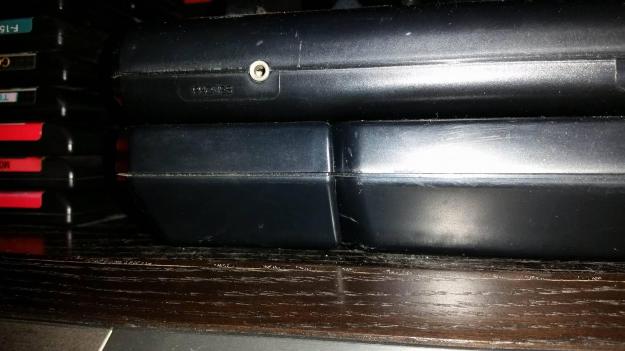
Finally, and for purely cosmetic reasons, I bought the extender piece that attaches to the far-left bottom of the Genesis and slides into the CD base. It doesn’t do anything but make the whole set-up look better; otherwise, the edge of the model 1 Genesis hangs off the side of the model 2 CD. Still plays fine, but looks ugly. Hence, extender piece. I wugs u extendo peece.
The more I think about it, the more I think that a particularly appealing thing about the Sega CD is that it’s such an early-1990s throwback, and not just in release date, either. Back then, CD was this new, wondrous format; just hearing “CD-ROM” today reminds me of getting the latest Sierra adventure games for the PC on CD – 3.5 floppies seemed so outdated after that! To get that same experience on a console, it had to be pretty cool for cutting-edge gamers of the time, and it’s still fun to revel in now, even if the revolutionary aspects have, of course, dimmed in the years since.
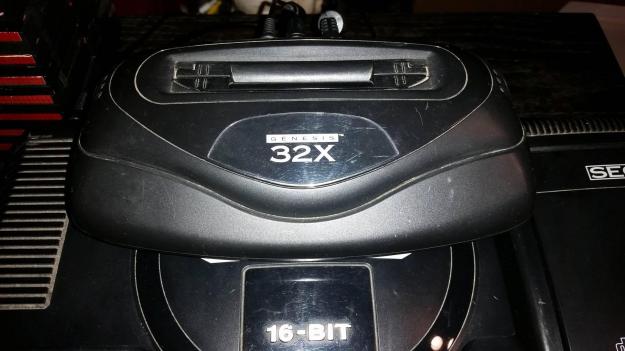
Ah, and that brings us to the the Sega 32x. The infamous Sega 32x. An attachment conceived to give the Genesis 32-bit capabilities, extend the life of the console, and bridge the gap between the Genesis and looming Sega Saturn, the 32x could very well be (and has been) considered the opening salvo in Sega’s demise as a console-maker. The add-on was a notorious flop, with only about 40 games released for it, and it was only on the market for 2 years or so. Even worse, it destroyed much confidence in Sega as a company, and coupled with some unwise decisions and relative commercial failure of the Sega Saturn (commercial failure, mind you, because it certainly has a huge cult following), Sega could never quite get back on track, even when they should have with the terrific Sega Dreamcast.
‘Course, in my case, I got the 32x so many years after all that, that there were only two real factors in deciding whether I should extricate it from its resting place and hook it up to my ‘real’ Genesis: 1) Were there enough games to even make it worth the effort? And, 2) what about my Power Case Converter? As I said before, that thing apparently won’t run whilst plugged in to the 32x (however, and also as I said before, you can run regular Genesis cartridges through it no problem, except for Virtua Racing, which the 32x has its own port of anyway). Like I mentioned earlier, rendering the Power Base Converter useless was non-negotiable in my eyes. I eventually found a not-perfect-but-livable solution, which I’ll explain in a bit.
(Like the Sega CD, the 32x has metal plates you’re supposed to install inside the Genesis cartridge slot, and while I have them, you don’t absolutely need them – also just like the Sega CD. This is a good thing, because they would hamper my just-mentioned SMS-solution, and besides, I don’t know where I put the things anyway.)
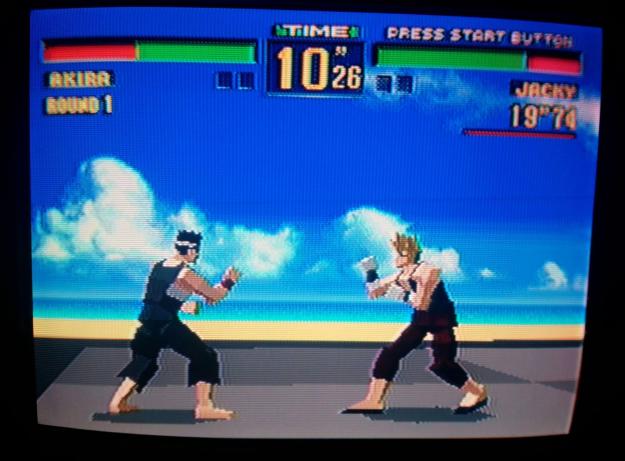
You know, even though there are far fewer games in the 32x library than there is the CD, there were a handful titles that I wanted to play more than any other, save Final Fight CD. Namely, Star Wars Arcade, Doom, and Virtua Fighter.
Star Wars Arcade was a launch title for the 32x in 1994. Based on the 1993 arcade game (as opposed to the 1983 vector Atari arcade game), it’s a very good space-shooter, and an excellent demonstration of the 32x’s polygon abilities. Plus, it was the one 32x game I played back in the day. Still, I haven’t spent a ton of time with this one yet.
Doom, on the other hand, has gotten far more playtime than I expected. I heard conflicting stories about this port, from it being good to it being, uh, not. And you know, even though the music is weak, the framerate sometimes stutters, there are levels missing, and some save states are desperately needed, for a time I could not get enough of this game! *I* think it’s a good port, even if, technically it’s not a great one. Plus, while it may be anathema to admit this, I’ve always preferred Wolfenstein 3D to Doom; since there was no port of the former on the 32x, the latter wins by default.
But as far as 32x favorites go, I think I have to give the edge to Virtua Fighter (above, again in a sad, off-the-TV shot), a terrific port of the revolutionary 1993 arcade game. Using polygonal models, it may not look like much now, but it’s a fantastic demonstration of just what the 32x could do when harnessed properly. It even compares quite well to the later Sega Saturn port! There was a time when I was big into the 3D one-on-one fighters, so this version of Virtua Fighter really does take me right back. Plus, I always wished that Sega had made a big beefed up Genesis port using the same technology they did for Virtua Racing; it never happened (though an okay, albeit 2D, port of Virtua Fighter 2 did show up late in the Genesis lifecycle), so this cart satisfies that ‘hunger’ somewhat.
Currently on the want list: Mortal Kombat II received a 32x port that’s seemingly pretty good, which is fortunate, since I love the regular Genesis version. Furthermore, there are well-regarded ports of Afterburner and Space Harrier that I definitely want. Knuckles Chaotix seems like an interesting Sonic spin-off, and the masochist in me wants to try Motocross Championship, even though it’s supposedly one of the worst things ever – and Youtube vids seem to bear that out. Also, I wouldn’t say no to Spider-Man: Web of Fire, should I find it cheap at a yard sale (yeah, right). Yes, there are fewer personal “wanted” games for the 32x than there are for the CD, but truth be told, the ones I want for the 32x I want more. Go figure!
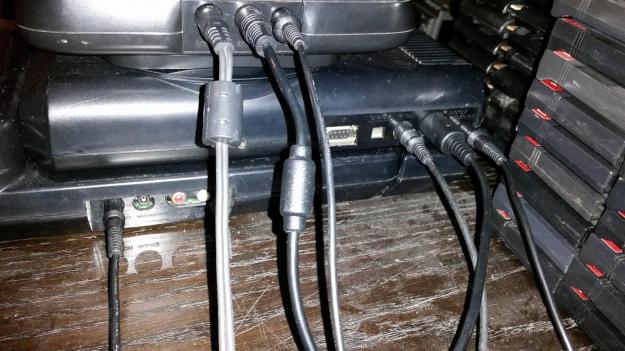
As you may well imagine, running all of this results in a real mess of wires, not to mention three separate power adapters. Look up above if y’all don’t believe me! And, the 32x was a real pain to get hooked up satisfactorily. You can’t just “plug it in” like the Sega CD. I didn’t think I had all the necessary cables here either, though it turns out I was only missing one – the most important one (figures). Online searches on what exactly I needed wound up making my head swim, especially when they got into what was needed to get true stereo sound out of a 32x plugged into a model 1 Genesis (which only outputs mono sound). I’m usually pretty good at figuring these things out myself, but here, after numerous tries, I kept finding myself hopelessly confused.
So, here’s what you need for the 32x:
1 – A power adapter, of course. The 32x uses the same style as the Genesis model 2. Mine came with one, and even if it hadn’t, they’re easily found.
2 – Genesis 2-style AV or RF cables. Mine came with an RF box, which was fine with me until I realized I was gonna need AVs not only for better picture (remember, I wasn’t using the shielding plates, which did result in some irritating static), but also for a very specific reason I’m coming to. A quick trip to eBay yielded me some (cheap) AVs, though I soon learned the hard way that normal Genesis 2 stereo AV cables don’t work; you get picture but no sound with them plugged into the TVs AV ports. Nope, here you gotta have mono Genesis 2 AVs in this situation. Evidently they came with the 32x originally. So there went a bit more money for the cause, but they worked. Of course, you’ll only get mono sound in this scenario, but stereo isn’t that important to me here, and besides, figuring that aspect out takes me back to head-swimmin’ territory. Enough of that noise.
3 – Here’s what I didn’t originally have, and also what resulted in the most confusion on my part: The 32x AV mix cable. You see, you have to route from the Genesis AV port to the 32x with this cable in order to see everything correctly, via the “AV out” port on the Genesis and the “AV in” port on the 32x. Not so hard to understand, except the Genesis 1 and the Genesis 2 use different AV ports, and the model 2 port is the same one as found on the 32x. So, the 32x originally came with an adapter that fit the cable into the Genesis 1. It sounds so simple now, but figuring out what people were talking about, again, had my head swimming. I actually had to go to a video game forum and ask where I was at with what I had. Since the original adapters for this cable are pricey nowadays, I opted for a third party cable that’s specifically built to connect the Genesis 1 to the 32x, and I’ve had no complaints.
So, what about my beloved Power Base Converter? Just how was I gonna play SMS games without doing some serious un-hooking? Well, it’s not an ideal situation, but since I now have AV cables for the 32x, and thus normally run all of my Genesis-needs through those, I simply plugged and left my model 1 RF switchbox into the TV, and whenever I feel the need for some SMS, I’ll take out the 32x, unhook the AV cables from the Genesis, plug the RF cable back in, and have at it. No, it’s not as quick and easy as I’d like, but the effort is fairly minimal, and besides, I can still keep all of my stuff in one location, on top of my big honkin’ TV.
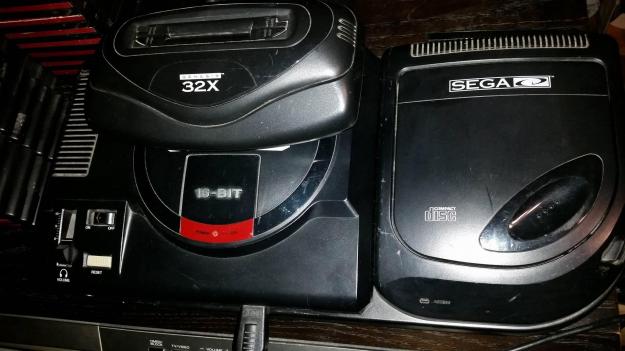
And so, there it be: A model 1 Sega Genesis, loaded, cocked and ready to rock, with a Sega CD and Sega 32x attached, and though not pictured, a Power Base Converter at the ready. Yes, it looks like a big plastic lump sitting on top of my TV. No, I don’t care; in one sitting I can play Rambo III, Virtua Fighter, Final Fight CD and Vigilante if I want, and that’s a thing of beauty.
You know, I was there for the tail-end of the 8-bit era, but basically grew up during the 16-bit generation, not to mention the 32/64-bit years. After that, my interests progressively waned generation-by-generation. But 8-bit and 16-bit, that’s where my gaming heart always truly stayed; I upgraded over the years, sure, but I never stopped loving the consoles and/or eras I grew up with. Since most of those formative-gaming-years took place in the 1990s, man, this beefy monstrosity of a console really does take me back, even if I didn’t actually own most of it when it was new.
And on the subject of the 1990s, I’ve come to consider the Sega Genesis the definitive 1990s console. Let me explain: I’m not necessarily saying it’s the best console of the 1990s; that’s of course subjective, and I absolutely adore the Super Nintendo, which was my first system ever (Christmas of 1992, baby!). Plus, the 1990s also held the 32/64-bitters, and it’s safe to say the Sony Playstation dominated the second-half of the decade handily. (Though for sheer late-1990s-ness, the Nintendo 64 seems to fit to me, too.)
But when I think 1990s gaming, the Genesis defines so much of what comes to mind. Here’s a system that hit the US in 1989, and stuck around until 1998 or so. (Wikipedia says 1999!) The sleek, black console itself, sure, it looks like a product of the decade (even if it technically wasn’t when regarding my preferred model 1), but also the many different trends and styles of gaming it demonstrated. From the 8-bit sensibilities (with 16-bit graphics) of the early titles, to Sonic, to the innovative, technically-impressive stuff being produced in the later years.
And beyond the games themselves, there was the ‘aura’ of the console; the loud, in-your-face marketing (“Blast Processing,” “SEGA!”) and general aimed-at-adults attitude. It all seems so overtly 1990s now. And of course, it’s also the additional features (some might say gimmicks) such as the Sega Channel, and, naturally, Sega CD and 32x add-ons, that all make up the “1990s-ness” of the Genesis. Sega ultimately wound up shooting themselves in the foot by doing “too much” with the system, but as an artifact of the mid-1990s, man, this beefed-up console just screams “1995!!” to me. I love it!
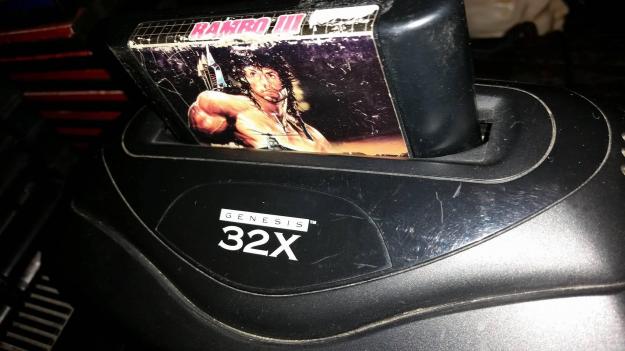
Looking for a succinct picture to sum up my super-charged Sega Genesis? This one right here seems to fit the bill. The classic 16-bit Sega Genesis, being upgraded to the aforementioned “NEXT LEVEL.” In one system I can take part in genuine 16-bit greatness, venture into the then-fairly-new world of CD-ROM, take a peak into the future with 32-bit gaming, or take a look back at the past with 8-bit gaming; how cool is that?! Do I need any more reasons to keep all this on top of my Trinitron for the foreseeable future? I posit that I do not.
SEGA = BEEFED, and I couldn’t be happier with the results!
